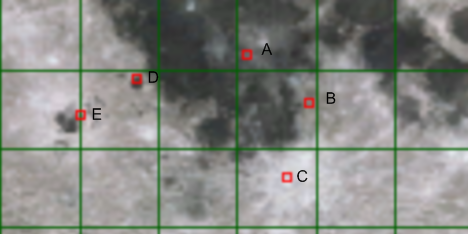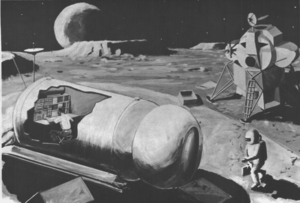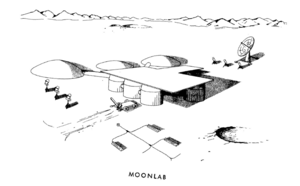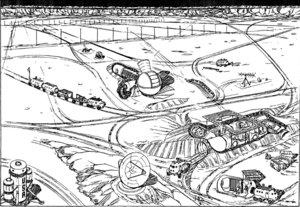Moonbases: Difference between revisions
imported>Graham2001 No edit summary |
imported>Graham2001 (Added all available information on the 1971 Lunar Orbiting Space Station.) |
||
| Line 70: | Line 70: | ||
<br clear="right"> | <br clear="right"> | ||
==North American/Rockwell: Orbiting Lunar Station (1971)== | |||
To accompany the Lunar Surface Base, North American/Rockwell designed a lunar space station that was to be placed into a lunar polar orbit approximately two years before the surface base was constructed. | |||
It would then conduct site surveys and once the surface base was in operation would act to support the manned surface operations. | |||
<br clear="right"> | |||
==References== | ==References== | ||
| Line 78: | Line 87: | ||
* Stanford-Ames, ''[http://ntrs.nasa.gov/archive/nasa/casi.ntrs.nasa.gov/19690020460_1969020460.pdf Preliminary Design Of A Manned Lunar Laboratory. A Stanford Ames Summer Faculty Workshop Study 24 Jun. - 6 Sep. 1968]'', October 1968 | * Stanford-Ames, ''[http://ntrs.nasa.gov/archive/nasa/casi.ntrs.nasa.gov/19690020460_1969020460.pdf Preliminary Design Of A Manned Lunar Laboratory. A Stanford Ames Summer Faculty Workshop Study 24 Jun. - 6 Sep. 1968]'', October 1968 | ||
* Stanford-Ames, ''[http://ntrs.nasa.gov/archive/nasa/casi.ntrs.nasa.gov/19700078042_1970078042.pdf Moonlab - A design for a semipermanent lunar base]'', January 1969 | * Stanford-Ames, ''[http://ntrs.nasa.gov/archive/nasa/casi.ntrs.nasa.gov/19700078042_1970078042.pdf Moonlab - A design for a semipermanent lunar base]'', January 1969 | ||
* North American/Rockwell, ''[http://ntrs.nasa.gov/archive/nasa/casi.ntrs.nasa.gov/19710015273_1971015273.pdf Orbiting Lunar Station Phase A Feasibility and Definition Study. Final Report - Condensed Summary Report]'', April, 1971 | |||
* North American/Rockwell, ''[http://ntrs.nasa.gov/archive/nasa/casi.ntrs.nasa.gov/19710016356_1971016356.pdf Orbiting Lunar Station Phase A Feasibility and Definition Study. Final Report Vol.1 - OLS Objectives]'', April, 1971 | |||
* North American/Rockwell, ''[http://ntrs.nasa.gov/archive/nasa/casi.ntrs.nasa.gov/19710016357_1971016357.pdf Orbiting Lunar Station Phase A Feasibility and Definition Study. Final Report Vol.2 - Mission Operations]'', April, 1971 | |||
* North American/Rockwell, ''[http://ntrs.nasa.gov/archive/nasa/casi.ntrs.nasa.gov/19710016358_1971016358.pdf Orbiting Lunar Station Phase A Feasibility and Definition Study. Final Report Vol.3 - OLS Performance Requirements]'', April, 1971 | |||
* North American/Rockwell, ''[http://ntrs.nasa.gov/archive/nasa/casi.ntrs.nasa.gov/19710015626_1971015626.pdf Orbiting Lunar Station Phase A Feasibility and Definition Study. Final Report Vol.6 - Comparison Of OLS Configurations]'', April, 1971 | |||
* North American/Rockwell, ''[http://ntrs.nasa.gov/archive/nasa/casi.ntrs.nasa.gov/19710016381_1971016381.pdf Lunar Base Synthesis Study. Final Report Vol.1 - Executive Study]'', May, 1971 | * North American/Rockwell, ''[http://ntrs.nasa.gov/archive/nasa/casi.ntrs.nasa.gov/19710016381_1971016381.pdf Lunar Base Synthesis Study. Final Report Vol.1 - Executive Study]'', May, 1971 | ||
* North American/Rockwell, ''[http://ntrs.nasa.gov/archive/nasa/casi.ntrs.nasa.gov/19710016382_1971016382.pdf Lunar Base Synthesis Study. Final Report Vol.2 - Mission Analysis and Lunar Base Synthesis]'', May, 1971 | * North American/Rockwell, ''[http://ntrs.nasa.gov/archive/nasa/casi.ntrs.nasa.gov/19710016382_1971016382.pdf Lunar Base Synthesis Study. Final Report Vol.2 - Mission Analysis and Lunar Base Synthesis]'', May, 1971 | ||
Revision as of 12:54, 22 June 2008

In many pre NASA lunar exploration plans a permanent or semi-permanent moonbase located either on the lunar surface or in lunar orbit was considered as the culmination of the exploration of the Moon. From this base astronauts would study the geophysical and near space environment of the Moon for an extended period of time.
During the Apollo period (1961-1972) NASA considered variety of Moonbase designs that could support anywhere from 2 men for a week up to 24 men for a period of 2 years.
Boeing: Modular Lunar Base System (1964)

One of the first major studies into a Moonbase was carried out by Boeing. They envisaged a base constructed of pre-fitted habitation modules that would be launched using the Saturn V INT-21 and landed on the lunar surface by remote control. Starting from an initial base capable of supporting three men for three months, the base would be expanded until it was capable of supporting twenty four men for over two years.
Crew transport would be by Apollo derivative spacecraft capable of carrying the entire three man crew to the lunar surface.
The primary focus of the base would be geophysical studies designed to follow up and extend the findings of the initial Apollo landings.
Three locations were considered for the base (See map at top of page):
Site A: 5.6ºN by 26.6ºW. This was a location considered as an early Apollo landing site. Approximately 241Km (150Mi) southwest of Copernicus, the site contained various surface features (Domes, small craters, Copernicus ejecta) that was considered of interest to scientists.
Site B: 12.6ºS by 2.9ºW. Located inside the crater Alphonsus, this base would give astronauts access to a region that was suspected to be volcanically active and thus potentially give them a window into the Moons interior.
Site C: 40.9ºS by 11.1ºW. Situated between the craters Tycho and Tycho 'A', a base at this location would have given the astronauts access to one of the Moons more prominent craters.
Goodyear: Stay Time Extension Module (1965)


In response to NASAs request for a means to extend the time astronauts could stay on the lunar surface the Goodyear Corporation designed an inflatable lunar shelter, called the Stay Time Extension Module, that could be carried folded up against the LM in place of the LRV. It was intended to support two men on the lunar surface for eight days.
In addition to the 'extended H-Mission' profile outline above, with the use of an unmanned LM to carry the shelter while the manned unit carried the LRV an 'extended J-Mission' profile allowing for a 14 day stay on the lunar surface was also possible.
Stanford-Ames: Moonlab (1968)

A year before the first Apollo landings, Stanford-Ames carried out a Moonbase design study. The resulting lunar base was partly inspired by the earlier Boeing design. It was to be constructed over the period 1976-1985 from modules launched using Saturn V INT-21s and modified Apollo CSM/LMs would carry astronauts from Earth to the base and back.
For this reason it was decided that the best location for the base would be inside the crater Grimaldi (Site D: 3.5ºS by 68.0ºW), a portion of the lunar surface that could be reached using standard Apollo spacecraft.
From this location the bases 24 man crew would conduct astronomical observations and lunar geological research.
McDonnell Douglas: Lunar Skylab (1970)
McDonnell Douglas (Seal Beach, CA) did a study on modifying the Skylab as a moon-orbiting observatory and station.
See Astronautix.
North American/Rockwell: Lunar Surface Base (1971)

The 1971 North American/Rockwell study was part of the Integrated Manned Programme. It was also the last Moonbase study during the Apollo period and the only one that incorporated Apollo experience into the planning.
Like the previous studies, the base was going to be constructed of modules. In this case the modules would be modified versions of those intended for NASA's post-Skylab space station.
The 12 man base would support not only long range geological traverses of the lunar surface, but visual and radio astronomy.
The designers simulated the base at a number of locations on the lunar surface, but selected as the optimum location a then unnamed crater inside the borders of Mare Orientale (Site E: 17.5ºS by 89.5ºW ).
North American/Rockwell: Orbiting Lunar Station (1971)
To accompany the Lunar Surface Base, North American/Rockwell designed a lunar space station that was to be placed into a lunar polar orbit approximately two years before the surface base was constructed.
It would then conduct site surveys and once the surface base was in operation would act to support the manned surface operations.
References
- Boeing, Initial Concept Of Lunar Exploration Systems For Apollo. Volume I - Summary, March 1964
- Boeing, Initial Concept Of Lunar Exploration Systems For Apollo. Volume V - Summary Digest, March 1964
- Goodyear Aerospace Corporation, Lunar Stay Time Extension Module STEM FINAL report, 21 Aug. 1964 - 20 Aug. 1965, August 1965
- Stanford-Ames, Preliminary Design Of A Manned Lunar Laboratory. A Stanford Ames Summer Faculty Workshop Study 24 Jun. - 6 Sep. 1968, October 1968
- Stanford-Ames, Moonlab - A design for a semipermanent lunar base, January 1969
- North American/Rockwell, Orbiting Lunar Station Phase A Feasibility and Definition Study. Final Report - Condensed Summary Report, April, 1971
- North American/Rockwell, Orbiting Lunar Station Phase A Feasibility and Definition Study. Final Report Vol.1 - OLS Objectives, April, 1971
- North American/Rockwell, Orbiting Lunar Station Phase A Feasibility and Definition Study. Final Report Vol.2 - Mission Operations, April, 1971
- North American/Rockwell, Orbiting Lunar Station Phase A Feasibility and Definition Study. Final Report Vol.3 - OLS Performance Requirements, April, 1971
- North American/Rockwell, Orbiting Lunar Station Phase A Feasibility and Definition Study. Final Report Vol.6 - Comparison Of OLS Configurations, April, 1971
- North American/Rockwell, Lunar Base Synthesis Study. Final Report Vol.1 - Executive Study, May, 1971
- North American/Rockwell, Lunar Base Synthesis Study. Final Report Vol.2 - Mission Analysis and Lunar Base Synthesis, May, 1971
- North American/Rockwell, Lunar Base Synthesis Study. Final Report Vol.2 - Appendixes, May, 1971
- North American/Rockwell, Lunar Base Synthesis Study. Final Report Vol.3 - Shelter Design, May, 1971
- North American/Rockwell, Lunar Base Synthesis Study. Final Report Vol.3 - Appendixes, May, 1971
- North American/Rockwell, Lunar Base Synthesis Study. Final Report Vol.4 - Cost and Resource Estimates, May, 1971